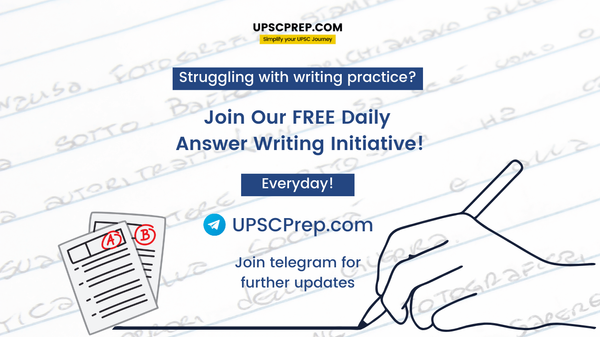Subject: GS 2
Syllabus: Governance
Questions
- How can we ensure that the bureaucracy functions as a strong support system and makes decisions that prioritise the best interests of the people, aligning with the motto of "minimum government and maximum governance"?
(150 Words, 10 Marks) - E-governance is an important tool to ensure citizen friendly services in a time bound manner. What are the challenges in e-governance and enumerate a few initiatives taken by the government? (150 words, 10 marks)
Download Model Structures PDF
Model Structures
Q10. Citizens charter is an instrument of organizational transparency and accountability that ensures the power of people stays above the people in power. Discuss and enumerate the challenges involved in implementing a citizen charter. (150 words) 10
Model StructureIntroduction:
- Citizen’s Charter is a systematic document underlining the commitment of an organization towards its beneficiaries and stakeholders as far as quality of services, choice, accessibility, information availability, cost-effectiveness and grievance redressal are concerned.
Main body:
- It is a tool of organizational transparency and accountability because-
- With clear aims of the organisation, it increases participation.
- It reduces corruption by improving transparency.
- It reduces cost and red-tape, thus bringing in good governance.
- It provides better access and choice which means democratization of services.
- There is constant improvement in services.
- By this, it ensures that the power of people stays above because-
- Involvement of all stakeholders in its formulation ensures that the charter meets desirable standards.
- It is a deterrent to misadministration and promotes good governance.
- It makes the government credible, thus improving social contract.
- It is a feedback loop to revamp people’s faith in administration by grievance redressal.
- It hasn't been effective till now due to challenges like-
- Lack of trained staff and financial resources.
- Not formulated by the consultation process and unavailable in the vernacular language.
- Inertia and rule-based stance of officers.
- Inadequate awareness among people thus low utility even if the charter is present.
- No legal backing for charter formulation and implementation, thus making it non-enforceable.
- Design issues, thus critical information missing.
- Rarely updated with changing times.
- It can be further improved by incorporating good aspects of the Sevottam model which is based on-
- Empowerment of citizens by which they can avail information and
- Grievance redressal with a prompt feedback mechanism.
- Timely service delivery.
Conclusion:
- Aims and vision of each section within a department are different and thus need to be formulated at the smallest level and then integrated at the highest level, like at the ministerial level. This will make it holistic, followed by periodic evaluation and grievance redressal. Can include best practices from the Sevottam model to make it more effective.
Q6. Many committees have stressed the importance of the ‘cooling-off’ period for civil servants who quit services for contesting elections or retire normally and then enter politics. In light of this, do you think Civil Service Conduct Rules need a relook? (150 words) 10
Model Structure
Introduction
- Civil servants are permanent executives and hold pivotal positions in governance and administration. They are policymakers at the top level and implementers at the ground level.
Main body
- To ensure the highest standards of integrity, objectivity, neutrality, professionalism etc and to work without fear or fervour, the concept of ‘cooling off’ period is there according to which there is a prohibition on employment after retirement for a certain period.
- The Civil Service Conduct Rules need a relook because-
- The purpose of ‘cooling off’ was defeated when the period was reduced to one year in 2015 from the earlier period of 2 years. It applies to group A and All India Services.
- There is central discretion if someone wants to take up a job within one year of leaving the job.
- Eg- when ex-foreign secretary Mr S Jaishankar joined Tata group without serving cooling off period.
- Other instances include an amendment in TRAI Act to appoint its chairman as principal secretary and current railway minister Shri Ashwini Vaishnaw quitting as IAS to join politics.
- These violations lead to a possible conflict of interest and crony capitalism.
- Civil service conduct rules can be improved by-
- Restoring the mandatory 2-year cooling-off period.
- Removal of exceptions as it violates the right to equality.
- Need to create distance between policy making and corporate interest. This must be ensured with a balance to a former officer's right to contest elections.
- Rules can be made to bar bureaucrats from contesting elections for one year, as advised by the Election Commission in 2012.
In this context, recommendations of the Hota committee called for a cooling-off period of 2 years post-retirement or resignation if an officer wants to join a political party. Retired civil servants shall not be appointed to constitutional posts like governor before 2 years cooling-off period.
Conclusion
- Cooling off period is a sine qua non for ensuring the faith of the public in bureaucracy and ultimately democracy. Certain reforms for cooling off as provided by the Indian Parliamentary Committee, Hota committee and ARC II must be looked into and adopted.

Write UnLimited Course (1 Year)
Write answers from any source, we will evaluate them for you.
